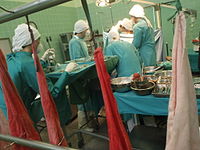
Photo from wikipedia
Nearly half of living liver donors in North America are women of child‐bearing age. Fetal and maternal outcomes after donation are unknown. We conducted a retrospective cohort study of female… Click to show full abstract
Nearly half of living liver donors in North America are women of child‐bearing age. Fetal and maternal outcomes after donation are unknown. We conducted a retrospective cohort study of female living liver donors (aged 18‐50 years at donation) from 6 transplant centers. Participants were surveyed about their pregnancies and fertility. Outcomes were compared between predonation and postdonation pregnancies. Generalized estimating equations were clustered on donor and adjusted for age at pregnancy, parity, and pregnancy year. Among the 276 donors surveyed, 151 donors responded (54.7% response rate) and reported 313 pregnancies; 168/199 (68.8%) of the predonation pregnancies and 82/114 (71.9%) of the postdonation pregnancies resulted in live births, whereas 16.6% and 24.6% resulted in miscarriage, respectively. Women with postdonation pregnancies were older (32.0 versus 26.7 years; P < 0.001) and more frequently reported abnormal liver enzymes during pregnancy (3.5% versus 0.0%; P = 0.02) and delivery via cesarean delivery (35.4% versus 19.7%; P = 0.01). On adjusted analysis, there was no difference in cesarean delivery (odds ratio [OR], 2.44; 95% confidence interval [95% CI], 0.98‐6.08), miscarriage (OR, 1.59; 95% CI, 0.78‐3.24), combined endpoints of pregnancy‐induced hypertension and preeclampsia (OR, 1.27; 95% CI, 0.36‐4.49), or intrauterine growth restriction and preterm birth (OR, 0.91; 95% CI, 0.19‐4.3). Of the 49 women who attempted pregnancy after donation, 11 (22.5%) self‐reported infertility; however, 8/11 (72.7%) eventually had live births. Aside from increased reporting of abnormal liver enzymes and cesarean deliveries, there was no significant difference in pregnancy outcomes before and after living liver donation. One‐fifth of women who attempt pregnancy after liver donation reported infertility, and although the majority went on to successful live births, further exploration is needed to understand the contributing factors. Future research should continue to monitor this patient‐centered outcome across a large cohort of donors.
Journal Title: Liver Transplantation
Year Published: 2021
Link to full text (if available)
Share on Social Media: Sign Up to like & get
recommendations!